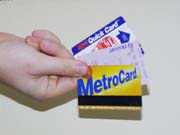When Laura DeFrancesco finally gets off the N train in Brooklyn every morning for work, she’s gone through three transportation systems, two states and four dollars.
As she plunked coins into the turnstile at the Exchange Place PATH station this week, the Bayonne resident – who takes the light rail, PATH and the subway – said she would welcome a way to eliminate the juggling of coins, bills and cards in her daily commute.
She may get her wish, as the metropolitan area’s train and bus systems are talking about creating a regional “smart card.”
“It would be good,” said DeFrancesco. “I would be in for that.”
It also would be good news for light rail and PATH rider James McEachin. “It’d save lots of time and stress,” he said. McEachin takes the light rail from Martin Luther King Drive in Jersey City to Exchange Place, where he takes the PATH to the World Trade Center and his job on Wall Street.
Officials at NJ Transit, the Port Authority of New York and New Jersey and the Metropolitan Transit Authority have been discussing plans for the card in recent months. Those talks were sparked by a U.S. Department of Transportation subsidiary report commissioned by those same transit systems, which called a fare card “feasible and desirable.” But compatibility and cost may bedevil plans for such “seamless travel.”
According to published reports, the Volpe National Transportation System Center of Cambridge, Mass. has recommended a wallet-sized silicon chip card for the New York region. The card system, according to the report, could cost $200 million to implement. It could be in place by 2003 for NJ Transit and the Port Authority; 2005 for New York City’s subway.
The Winter 2000 edition of the journal for the Volpe Center boasts, “From D.C. to L.A., transit riders may soon be able to leave their coins at home and board a bus or train by simply waving a card in front of an electronic sensor.”
Officials at area transit systems, nonetheless, are sounding a cautious note.
“I think we want to wait and see what comes out of the meetings with the other agencies,” said Port Authority spokesman Steve Coleman, “before we can say whether this will work or not.” Getting all the systems coordinated and the associated cost of such a plan are some of the things officials are hashing out.
“Each agency uses different technology to collect fares,” he said, “and you have to come up with one technology.”
As for the possibility that fares might have to be raised, officials don’t necessarily disagree.
“Everything has a price tag to it,” said Jeff Maclin, a spokesman for state transportation commissioner, NJ Transit board chair and Port Authority board member James Weinstein, a vocal advocate of the card plan. “That’s something the three transit properties are going to have to work out.”
Commuters may bristle at a fare hike for a new card, especially if the Port Authority adopts increases in PATH prices proposed late last year. U.S. Rep. Robert Menendez (D-13th Dist.) has publicly upbraided the Port Authority for the hike. The proposal would raise one-trip cash fares from $1 to $2, though a round-trip ticket would run $3. Ten-trip tickets would come to $15, twenty-trip tickets $30. A monthly pass of 46 trips would cost $60, up from $40. Public hearings on the increases will start later this month.
“Money is a factor,” said commuter DeFrancesco, “It’s a consideration.”
The Port Authority has argued that the fare increases are needed to ease congestion, buy more trains and make other improvements. The area’s transportation systems have surged with passengers in the last several years. Since 1991, NJ Transit’s ridership has risen by more than 30 percent. PATH ridership rose by a striking 10 percent in the first six months of 2000 alone, prompting the Port Authority to add trains and shorten the wait between those trains during rush hour.
Gov. Christine Todd Whitman has urged the creation of a regional fare card, and a recent State Assembly resolution recommended the implementation of the plan.
“Certainly it would seem logical to get all the companies together,” said sponsor of the resolution, Assemblyman Alex DeCroce of Parisppany-Troy Hills, in an interview last month.
“Why should a commuter who takes a New Jersey Transit bus to a PATH train to a New York City subway have to fumble with three different payment options instead of a single fare card?” he said.
For Stephen Dobrow, a professor of electrical engineering at Fairleigh Dickinson University and the head of Committee for a Better Transit, the card is a good idea.
“It gives the operators more flexibility and gives the user more convenience,” he said, “because they don’t have to carry all these cards.” But he wondered how the various systems would all work together and whether a regional fare structure would need to be implemented.
The Volpe Center has also helped Washington, D.C., in the implementation of a smart card system. The cards can store information, but are unlike credit cards, in that they merely store value and do not require authentication. But, the center says, “their simplicity and ease of use makes them especially useful for small, everyday transactions that often require the use of exact change: transit fares, parking fees, pay phones, tolls and food purchases.”
